Prevent your trees from the catastrophic damage they face when not planted, pruned and cared for properly. When you know what is involved in taking care of trees, you can keep them thriving.
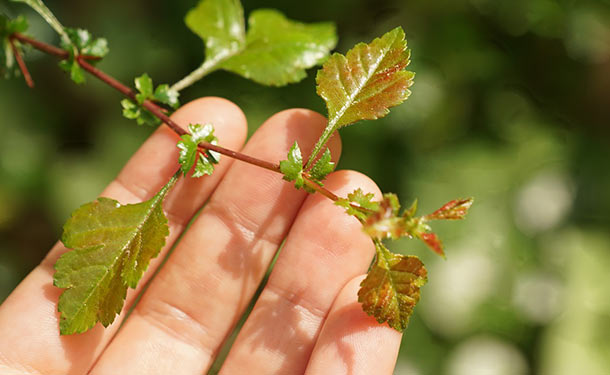
thetreecareguide.com gathered information on planting, watering, mulching, fertilizing, pruning, and inspecting your trees to keep them healthy.
Tree Planting
For most regions, fall is the best time to plant trees. Fall corresponds to the beginning of the dormant season (when tree metabolism and growth slow down). Planting in the fall reduces the chances of shock and allows the tree to self-establish before springtime (growing season). The following planting tips will help you get your tree off to a good start:
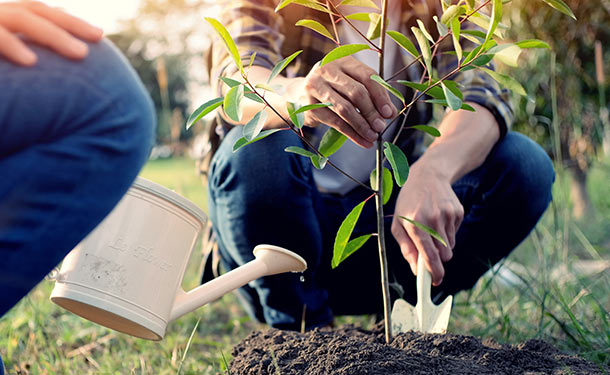
Location – Smaller trees up to 20ft tall (understory) should be planted from 6 to 10 feet away from each other or structures on your property. Medium-sized trees up to 35ft tall should be planted 10 to 15 feet away from each other and structures. Tall trees over 35ft tall (overstory) need 15 to 50 feet away from each other and structures.
Depth – At the base of your tree, you will notice an area that transforms from trunk to roots. The bulges where roots begin is called the root flare, and it is essential that it not be buried. When your tree is planted, the very top of the root flare should be visible.
Soil – The soil you plant your trees in should be a loamy soil with developed biodiversity, well-drained, and mixed with a high organic material ratio like compost.
Sun – Some trees do better in full sun than others. When planting a tree, be aware of the species requirements for sunlight and shade, then find a location that provides the best conditions for your tree.
Right Tree Right Place – The species you select for your property should be resistant to local insect or disease outbreaks and adapted to your USDA Hardiness Zone.
Tree Watering
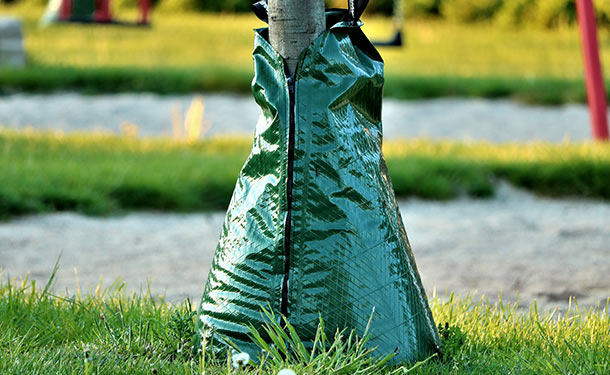
Tree watering is fundamental for the livelihood of a tree. Too much, and the roots may rot. Too little, and the tree may die from hydraulic failure. Consider the following when watering your trees:
Newly Planted Trees – For trees newly planted in well-drained soil, you’ll need to provide 2 gallons of water per inch of trunk measured across, 3ft above the root flare, every other day for the first 2 years.
Deep watering – Encourage deep root growth by providing a deep watering for your tree at least once per week. Deep waterings allow water to soak into the ground 12 to 18in or more.
Drought – In times of drought, you will need to increase the amount of water given to your tree. Young trees will look wilted, droopy, or dull in color when they are water-deprived. Avoid this type of stress, as it allows successful insect and disease attacks on your tree.
Avoid Overhead Watering – The majority of bacterial and fungal diseases that affect trees are spread by splashing water. Alternative watering methods like drip lines, watering bags, and buckets will help you keep tree diseases at bay.
Note: If your soil is too sandy (retains no water) or high in clay content (retains too much water), mix organic material into the soil and use a layer of it as mulch.
Read more about tree watering here.
Tree Mulching
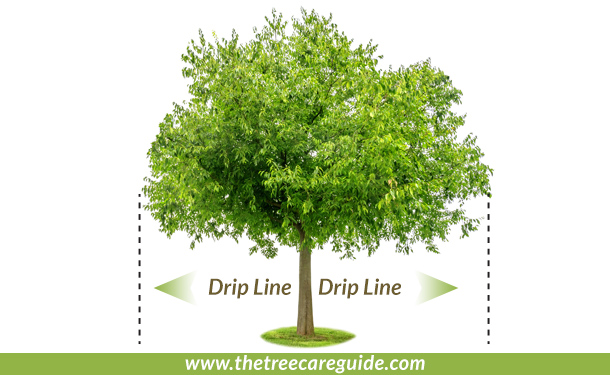
Mulching your tree protects its roots from extreme temperature swings and helps the soil retain moisture. Consider the following:
- Mulch your tree from the time you plant it.
- Mulch trees year-round.
- Use organic mulch that adds nutrients to the soil as it decomposes.
- A layer of mulch should be from 3 to 6-inches thick.
- Mulch should radiate from the trunk, extending just beyond the dripline.
- When mulch flattens or becomes matted, replace it or fluff it, mixing in new material.
- Pull mulch 3-inches away from the tree trunk to avoid rot.
- Avoid volcano mulching (mulch gets stacked against the trunk, resembling a volcano).
Note: Properly applied mulch will resemble a fluffy donut with a tree in the center.
Read about the dangers of volcano mulching.
Tree Fertilizing
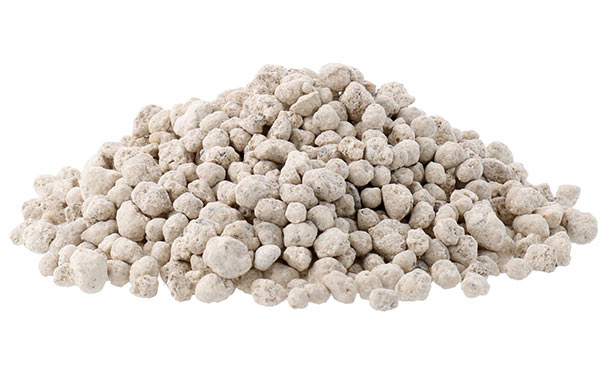
It may become necessary to feed your trees from time-to-time. However, before doing so, have your soil tested to measure nutrient and mineral content and the soil’s pH level. Send your soil sample to a university extension lab or professional laboratory. Soil test results reveal:
- Soil pH (most trees prefer slightly acidic soil with a pH of 6.1 to 6.9)
- Cation Exchange Capacity (measures the soil’s ability to retain elements and nutrients with positive charges or cations)
- Base Saturation (this is the distribution of cations in the soil)
Fertilizers come in a multitude of combinations and types. Most popular are granular, slow-release fertilizers, which include the components your soil test identified as deficient for optimum tree growth.
Read more about testing and improving your soil.
Tip: If you are uncertain about which laboratory to send your soil sample(s), ask your local nursery which one(s) they use.
Tree Pruning
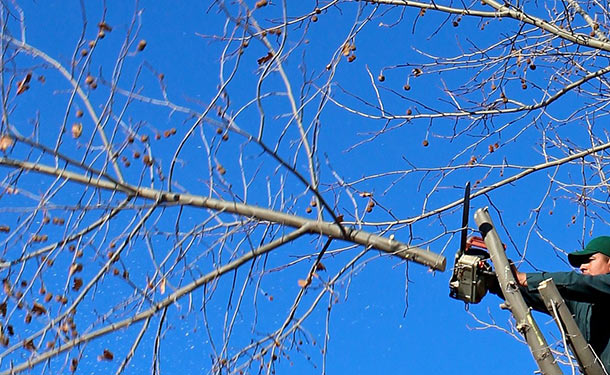
Tree trimming and/or pruning are essential tasks to keep your tree shaped, well-structured, and thriving. Consider the following before taking a saw to your tree:
Why Are You Pruning – Always know the purpose before beginning a pruning project. Is it to remove diseased, infested, or dead limbs? Or one of the following:
- Crown Raising
- Crown Thinning
- Crown Cleaning
- Height Reduction
Tree pruning can be highly beneficial or severely detrimental if you cut too much away or make improper cuts. It is highly recommended to contract a professional tree service when pruning more mature, heavier trees.
When To Prune – Your tree’s dormant season is the best time for most pruning activities. Other optimal times may include:
- When a limb or branch is diseased or infested
- When your tree suffers extreme weather damage
- When trees interfere with power lines
Tip: Except for emergencies, pruning activities should be avoided at the beginning of the fall season. This is the time when fungal spores and bacteria spread at peak levels.
Making Cuts – When making pruning cuts to remove a branch, a 3-cut method is recommended to avoid severe bark damage:
- Cut 1 (undercut) is made 6-inches from the trunk under the branch, cut in 1/4 way through the branch. This will prevent the tree’s bark from stripping away when the branch falls.
- Cut 2 is made 4 to 6-inches in front of the undercut. This is a top-down cut that severs the branch from the tree.
- Cut 3 removes the rest of the branch up to the trunk. This cut is made flush with the branch collar; you should use extra caution to not wound the branch collar. It is used to compartmentalize the wound and protect the tree from insects and disease.
Read the following article to learn more about Tree Pruning Purpose, Techniques, and Safety.
Tree Inspections (Hazard Assessments)

Schedule your professional tree service or arborist to visit your property each spring to perform a tree inspection or hazard assessment. These annual visits will help you identify developing problems before they can cause severe damage to your trees. Such problems may include:
- Insect Infestations
- Disease, Cankers, and Bark Damage
- Intersecting Branch Growth
- Leaning/Destabilization
- Root Rot
- Suckers/Water Sprouts
- Climbing Vines
- Winter Damage/Sunscald
- Lightning Damage
Tip: Schedule an inspection immediately after severe weather events such as tornadoes, hurricanes, floods, etc. these events can leave your tree(s) destabilized and dangerous to your property and well-being.
Tree Care
In this article, you discovered tree care information, including planting, mulching, fertilizing, pruning, and inspection tips and references to help you keep your trees thriving.
When you know how to properly take care of your trees, you can guide their growth through the best and worst conditions mother nature can throw at them.
Ignoring your trees’ basic necessities will leave them vulnerable to disease, infestation, and result in unhealthy growth, decline, and death.
Sources:
gardeningsolutions.ifas.ufl.edu/care/pruning/pruning-and-maintaining-trees.html
extension.umn.edu/planting-and-growing-guides/watering-newly-planted-trees-and-shrubs
extension.psu.edu/mulching-landscape-trees
csfs.colostate.edu/colorado-trees/selecting-planting-and-caring-for-trees/planting-tips/